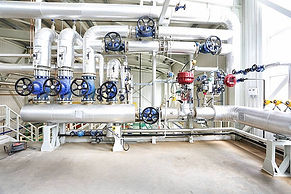
DiVYA
PHONE : +91-8374485833,
Mail : storagetanks@mail.com
INDUSTRIAL PIPING DESIGN CONULTANCY SERVICES

FRP Piping Design Services
Piping Design consultancy firm- FRP piping| Divya Engineering
Piping Design and Drafting: Creating detailed CAD drawings and design calculations for FRP piping systems used in power plants, refineries, and other industrial facilities.
Pipe Stress Analysis: Performing static and dynamic stress analysis using software like CAESAR II to ensure the FRP piping system can withstand operational and environmental stresses.
3D Modeling and Design: Using software such as PDS, PDMS, or Auto Plant to create 3D models of FRP piping systems for better visualization and accuracy.
Isometric/Fabrication/Erection Drawings: Preparing detailed drawings for the fabrication and installation of FRP piping systems.
Support Detail Drawing Preparation: Designing and detailing the necessary supports for the FRP piping system to ensure stability and safety.
Project Management: Managing the entire FRP piping design project from initial conceptualization through fabrication and commissioning.
Compliance with Standards: Ensuring that the design complies with relevant standards such as ASME B31.1 for power piping and ASME B31.3 for process piping.
BILL OF MATERIAL, INSULATION & EXPANSION JOINTS
Challenges in FRP Piping Design
While Fiber Reinforced Plastic (FRP) piping systems offer numerous advantages, such as corrosion resistance, lightweight construction, and cost-effectiveness, designing FRP piping can present a unique set of challenges. Addressing these challenges requires a deep understanding of the material properties and the specific requirements of each project. Some of the key challenges in FRP piping design include:
1. Material Selection
FRP pipes are made using various resin and reinforcement materials, each having different properties. Selecting the appropriate combination of resin, fibers, and additives is critical to ensure the pipe's performance under specific environmental conditions. Factors such as chemical resistance, temperature tolerance, pressure ratings, and durability need to be considered to select the most suitable material.
2. Design Codes and Standards
Unlike metal piping systems, FRP piping design lacks a universal set of widely recognized codes and standards. Various industry standards and guidelines may apply, such as ASTM, ASME, and ISO, but these may not be as extensive or detailed as those for traditional piping materials. Designers must have a thorough understanding of the relevant codes and adapt them as needed to ensure compliance and safety.
3. Handling Thermal Expansion
FRP pipes experience a higher rate of thermal expansion compared to metallic materials. This expansion and contraction can lead to stresses in the piping system, which must be considered in the design. Proper allowances for thermal expansion must be made, and methods like expansion loops, supports, and flexible joints may need to be incorporated into the system design.
4. Mechanical Strength and Pressure Rating
While FRP pipes are highly resistant to corrosion, they can be more susceptible to mechanical damage such as impact, compression, or buckling under pressure. Ensuring that the design accounts for the internal pressure, external loads, and other mechanical stresses is essential to avoid system failure. Pressure ratings must be carefully calculated based on the pipe's material strength and the operational conditions.
5. Joint Design and Integrity
The design and integrity of joints in FRP piping are a significant challenge. Unlike metal pipes, FRP pipes require specialized jointing methods, such as flanged connections, adhesive bonding, or mechanical coupling. Ensuring that these joints remain leak-free, especially under high pressure or corrosive conditions, requires careful material selection and design for long-term reliability.
6. Corrosion Resistance Considerations
Although FRP materials are known for their corrosion resistance, the pipes may still be vulnerable to certain chemicals or environmental conditions. Designing a piping system that maintains its integrity over time requires a thorough understanding of the chemical exposure and environmental conditions the system will face. Protective coatings or barriers may be necessary in some cases to prevent degradation.
7. Installation and Handling
FRP pipes are lightweight compared to traditional metal pipes, which makes them easier to handle and transport. However, they can be more susceptible to damage during installation due to their brittleness under certain conditions. Careful handling and proper installation procedures are necessary to avoid cracking, especially at the joints or during the bending process.
8. Long-Term Performance and Aging
Over time, the resin in FRP pipes can degrade due to factors such as UV exposure, temperature fluctuations, or chemical reactions. This can affect the pipe's performance and longevity. Ensuring that the system design accounts for these factors, including UV protection, coatings, and regular maintenance schedules, is crucial for long-term durability.
9. Cost Considerations
While FRP piping systems can be cost-effective in certain applications, the upfront costs can be higher than traditional materials like PVC or steel. Moreover, advanced design and manufacturing processes may increase costs in some projects. Balancing the long-term benefits of FRP systems with initial expenses and project budgets requires careful financial planning and analysis.
10. Quality Control and Testing
FRP piping systems must undergo rigorous quality control to ensure that the pipes and joints meet the required standards. This includes testing for pressure ratings, chemical resistance, and structural integrity. The variability in production processes and material quality can make ensuring uniformity a challenge, and manufacturers must implement stringent testing protocols to guarantee reliable performance.
In conclusion, designing FRP piping systems involves overcoming multiple technical challenges related to material properties, mechanical strength, thermal expansion, joint integrity, and long-term performance. Successful design requires expertise in material science, engineering principles, and a detailed understanding of the project requirements. By addressing these challenges, designers can create safe, durable, and efficient FRP piping systems that meet the needs of their clients while also ensuring long-term reliability and performance.



